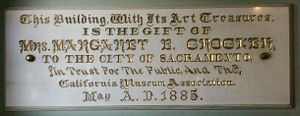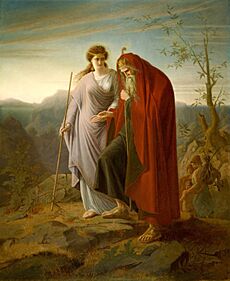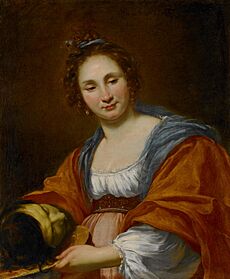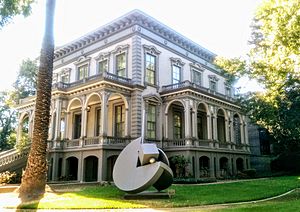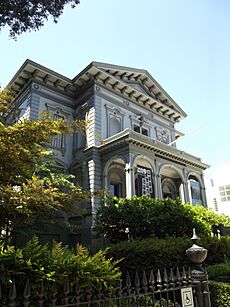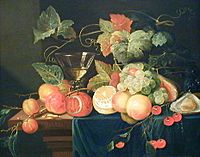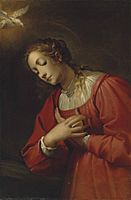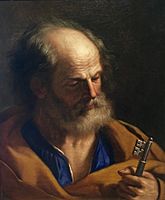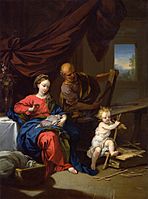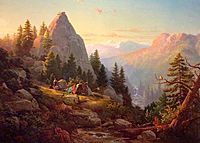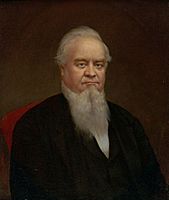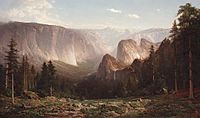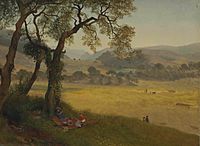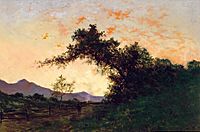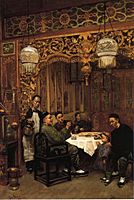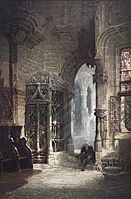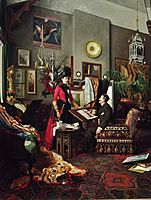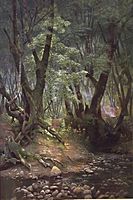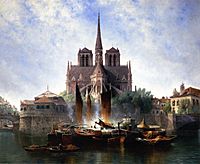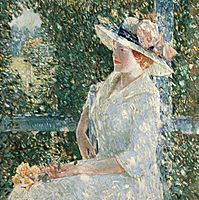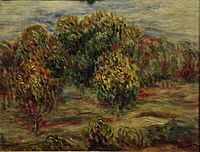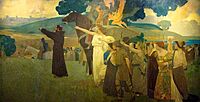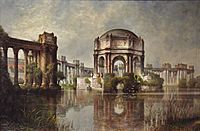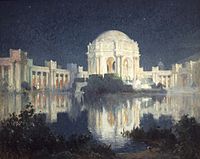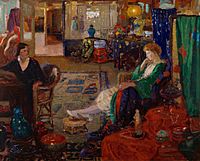Crocker Art Museum facts for kids
Quick facts for kids |
|
|
Crocker Art Museum
|
|

The old and new buildings of the Crocker Art Museum.
|
|
| Location | 216 O St., Sacramento, California |
|---|---|
| Built | 1871; addition 2010 |
| Architect | Seth Babson (1871); Charles Gwathmey (2010) |
| Architectural style | Italianate; Classic Contemporary |
| NRHP reference No. | 71000176 |
| Added to NRHP | May 6, 1971 |
The Crocker Art Museum is the oldest art museum in the Western United States. Located in Sacramento, California, it first opened in 1885. The museum is famous for its amazing collection of Californian art.
The museum's collection features American art from the Gold Rush era to today. It also has European paintings, master drawings, and one of the biggest international ceramics collections in the United States. You can also see art from Asia, Africa, and Oceania. The Crocker Art Museum is officially recognized by the American Alliance of Museums for its high standards.
Contents
The Story of the Museum
The museum's story begins with Edwin B. Crocker, a rich California lawyer, and his wife, Margaret Crocker. From 1869 to 1871, they traveled through Europe and started collecting many beautiful paintings and drawings.
When they returned to Sacramento, they decided to build a special art gallery next to their large home. Once finished, the gallery was opened to everyone. It became a popular place in Sacramento for social events and gatherings. Famous people like Queen Liliʻuokalani of Hawaii, President Ulysses S. Grant, and the writer Oscar Wilde all visited the gallery.
After Judge Crocker passed away in 1875, his wife Margaret wanted to make sure the art collection would be enjoyed for many years. In 1885, she generously gave the gallery and its valuable collection to the City of Sacramento and the California Museum Association. This gift was meant to be held "in trust for the public."
The gallery was renamed the Crocker Art Museum in 1978. As the collection grew bigger, the museum needed more space. In 2010, a large, modern new wing was opened, allowing the museum to show more of its art to the public.
The Museum's Art Collections
The Crocker Art Museum has a wide variety of art from different times and places.
Californian and American Art
This collection features art from California, from when it first became a state to the present day. The first pieces were collected by the Crocker family. They especially liked the work of Charles Christian Nahl, an artist who painted large, detailed scenes of the California Gold Rush.
Over the years, the collection has grown to include many styles, like Impressionism and Pop Art. It features famous Californian artists such as Wayne Thiebaud and David Park. The museum also has a strong collection of American art from outside California, with works by famous artists like Georgia O'Keeffe and Childe Hassam.
European Art
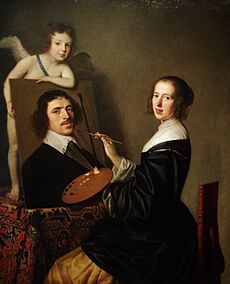
The European art collection started with the Crocker family's trip to Europe. They bought over 700 paintings, mostly from Germany. While they thought they were buying art from very famous masters, many paintings were by other talented artists of the time. This created a unique and interesting collection.
The collection includes paintings from the 17th-century Dutch Golden Age, as well as French and Italian art. Over the years, the museum has received many gifts, adding more amazing European art to its collection. These include works by famous artists like Simon Vouet and Sir Thomas Lawrence.
Art from Around the World
The museum also has impressive collections of art from other parts of the globe.
- Works on Paper: This collection has about 1,500 drawings by Old Masters from Europe, including famous artists like Albrecht Dürer and François Boucher. It also features modern American photography and prints.
- Asian Art: This collection started with a gift of Korean pottery. Today, it includes Chinese tomb art, Japanese armor, and beautiful miniature paintings from India and Persia.
- Ceramics: The museum showcases pottery from ancient times to modern day. You can see everything from 18th-century Meissen porcelain to works by modern artists.
- African and Oceanic Art: This collection features objects used in daily life and special ceremonies. A highlight is the tall, carved bis poles made by the Asmat people of New Guinea to honor their ancestors.
The Museum Buildings
The museum is made up of two main parts: the historic family home and a modern new wing.
The Historic Mansion and Gallery
In 1868, Judge Crocker bought a house and hired architect Seth Babson to design a grand gallery next to it. Babson created a beautiful building in the Italianate style, which was popular at the time.
The gallery building was very fancy. It had a bowling alley and skating rink on the ground floor. The public rooms were decorated with gold and beautiful paintings on the walls. This historic building is considered one of Babson's best works.
The 2010 Expansion
On October 10, 2010, the museum opened a huge new building called the Teel Family Pavilion. This expansion more than tripled the museum's size. It added much-needed space for traveling exhibits and for showing more of the museum's own collection.
The new wing also includes an education center with art classrooms, a library, and an auditorium. This modern building connects to the historic mansion, blending the old with the new.
Gallery of Artworks
Here are some of the famous artworks you can see at the Crocker Art Museum.
-
Guercino, Saint Peter, 1650
-
Claude-Joseph Vernet (1714-1789), Cain and Abel Bringing Their Sacrifices
-
Alexander Roslin, Anne Vallayer-Coster, 1783
-
Stephen William Shaw, E.B. Crocker, 1872
-
Albert Bierstadt, A Golden Summer Day Near Oakland, 1873
-
Pierre-Auguste Renoir, Cagnes Landscape, 1910
-
Edwin Deakin, Palace of Fine Arts and the Lagoon, 1915
-
Colin Campbell Cooper, Palace of Fine Arts, San Francisco, 1916


